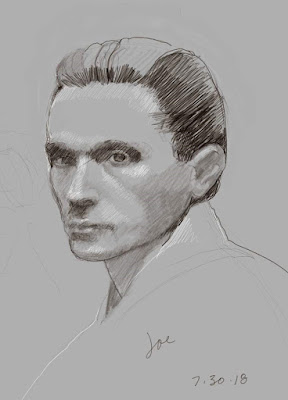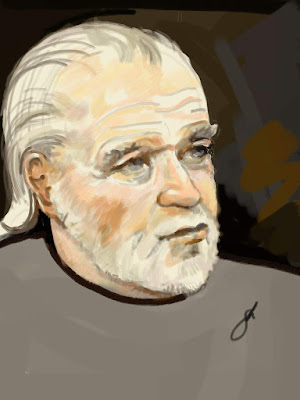 |
| "Breakfast-goers at the Fair," wc, 3.5x5.5 |
When Monday came it occurred to me that perhaps the early morning would be even quieter than previous early mornings. It's such a luscious time of day on the fairgrounds when most of the thousands of machines aren't running, there is not much music (hurdy-gurdy-like or bawling rock/country) and fewer visitors. The asphalt and concrete haven't heated to griddle-like temperatures either, and a soft breeze often moves through the sleepy grounds.
Mornings at the Fair start best with breakfast in one of the concessions. There are those who swear by cinammon rolls and coffee, but fair time calls for eggs. And sausage, or bacon, and hash browns, and yes, biscuits and gravy. Most of those who work and exhibit for the eleven days of the Fair often breakfast in one or another of the tents, and everyone gets to know one another. There's something old-time about coming onto the grounds, having a farmer's breakfast, and then tramping through the animal barns and exhibitions. Yesterday morning I saw a couple who are great representatives of the Fair, and of Iowa, having the morning coffee. His ten-gallon hat isn't the usual headwear for men (that would be a "gimme cap") but certainly recalls old times.
 |
| "In the Discovery Garden," ink, 5x8 |
After breakfast my feet took me back to the Discovery Garden just south of the Ag Building. The garden chairs there were considerably less busy. There were people walking through, of course, but you could actually see the garden beds and landscaping most of the time. For this drawing I did the stationary items--path, pergola, fence--in pencil and added the figures as they became interesting. None of the figures drawn were actually there together, but simply placed into the drawing. Afterward
I inked the drawing, changing and enhancing here and there. In some cases this is how the beginning for a watercolor sketch happens, but doing ink first requires using waterproof ink. It's simpler to draw lightly with pencil, paint, then ink as needed to enhance.
Although it wasn't really hot, the shaded area south of the Administration Building was my next stop for drawing. The area is shaded by dozens of mature trees that spread a cool darkness over the entire grounds encompassing the Bill Riley Stage, named for the man who emceed more than fifty years of talent shows at the Fair. The stage is open-air and permanent, with surrounding permanent seating. Even if there is no show going on it's a natural gathering place, behind a long row of food booths on three sides. So I spent a profitable period of time there on a bench alongside one of the paths that wind through, watching people walk by. As in the sketch above, for this one I sketched the fixed items--tree, food booth, path--and then added the figures as they came along. This kind of sketching exercise is great fun and gives a lot of memory practice, since nobody holds still at all. Catching the gesture is everything, which adds a lot to the fun.

With so many large animals to manage, it's no mistake that the Fair has people to assist with animal control. Since the animals in question can be enormous, horseback wranglers are important. These folks patrol the streets around the animal barns on horseback, patiently sitting astride, smiling at children, posing for photos, answering questions, and occasionally wrangling a steer or horse that's gotten frisky. But sitting astride a horse for hours, even when the horse isn't moving, can bring on substantial soreness and fatigue. As I was leaving Monday around midday I saw this rider taking a rest from sitting the saddle, and giving the horse a rest besides. Sometimes you just have to get down. I sketched this simple scene in graphite, about 3.5x6.
The Fair ends in a few days, but I'll continue visiting and sketching and posting for the next two or three days, until other subjects beckon. More Fair fun to come!
































